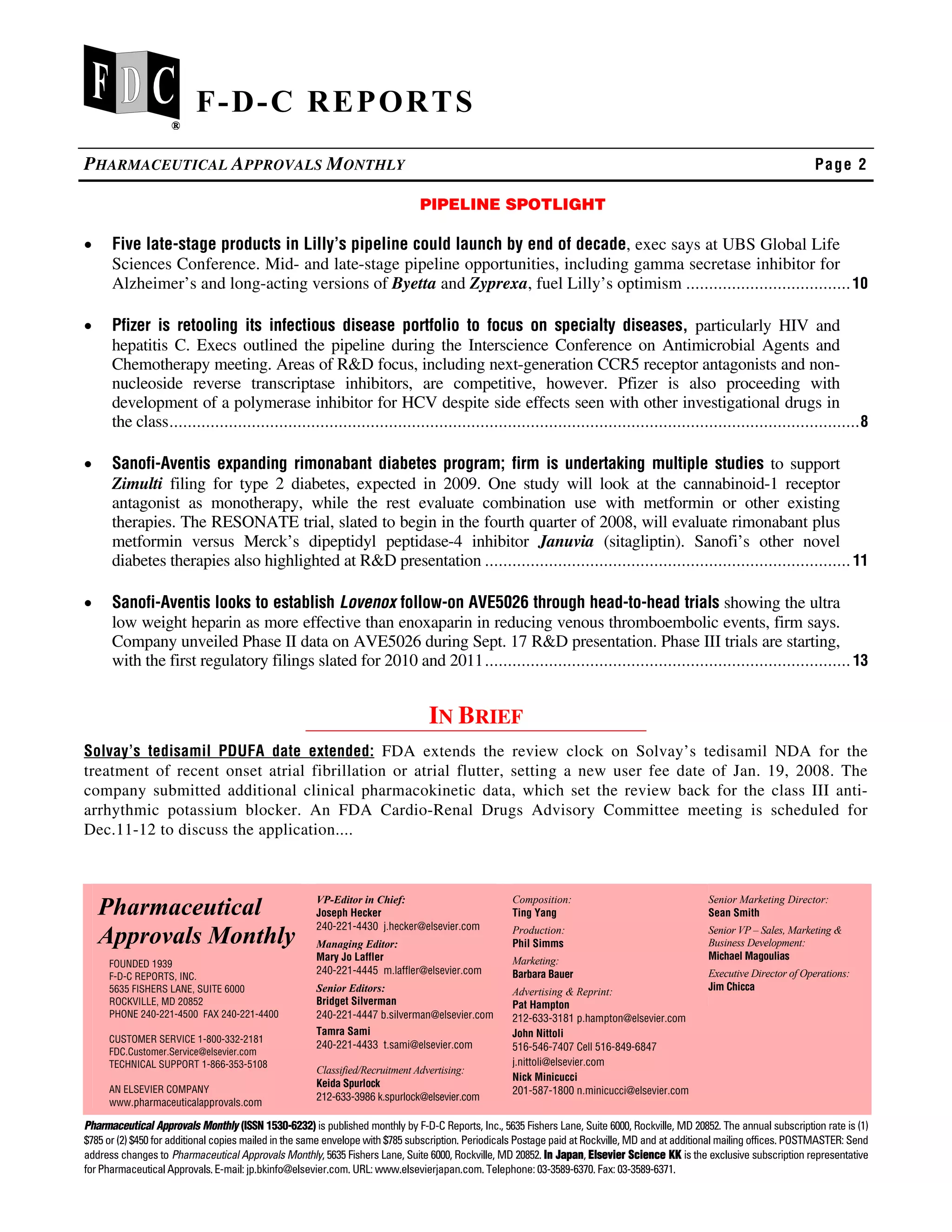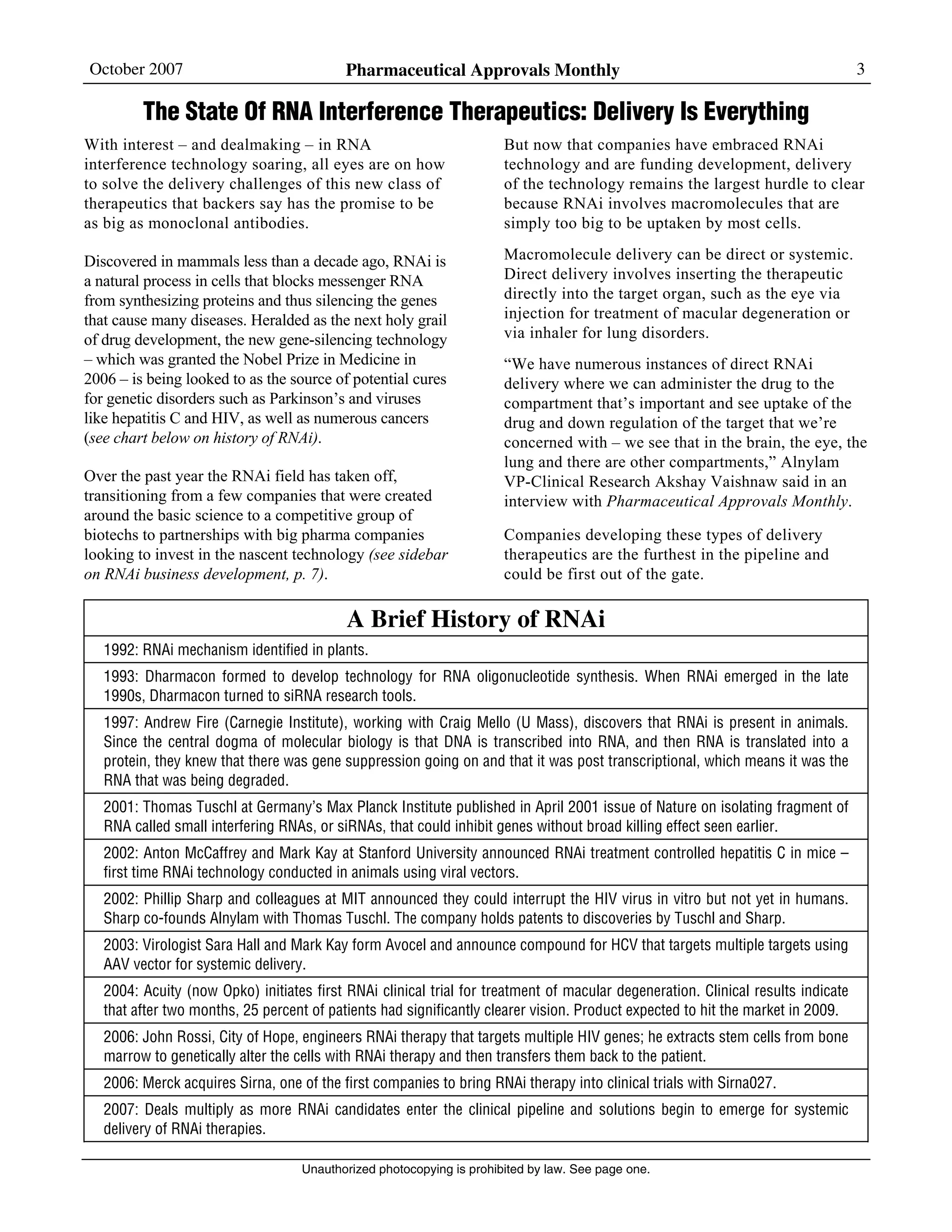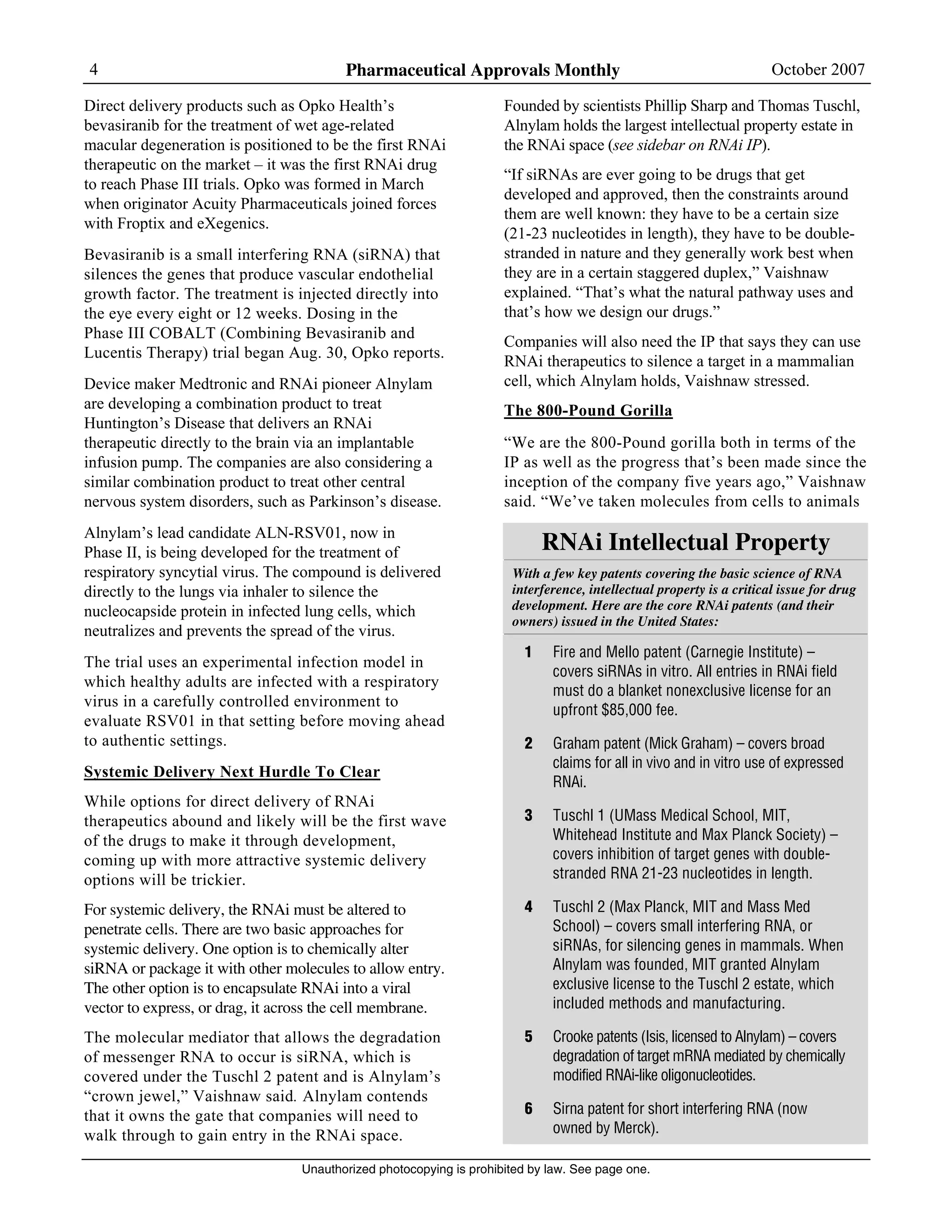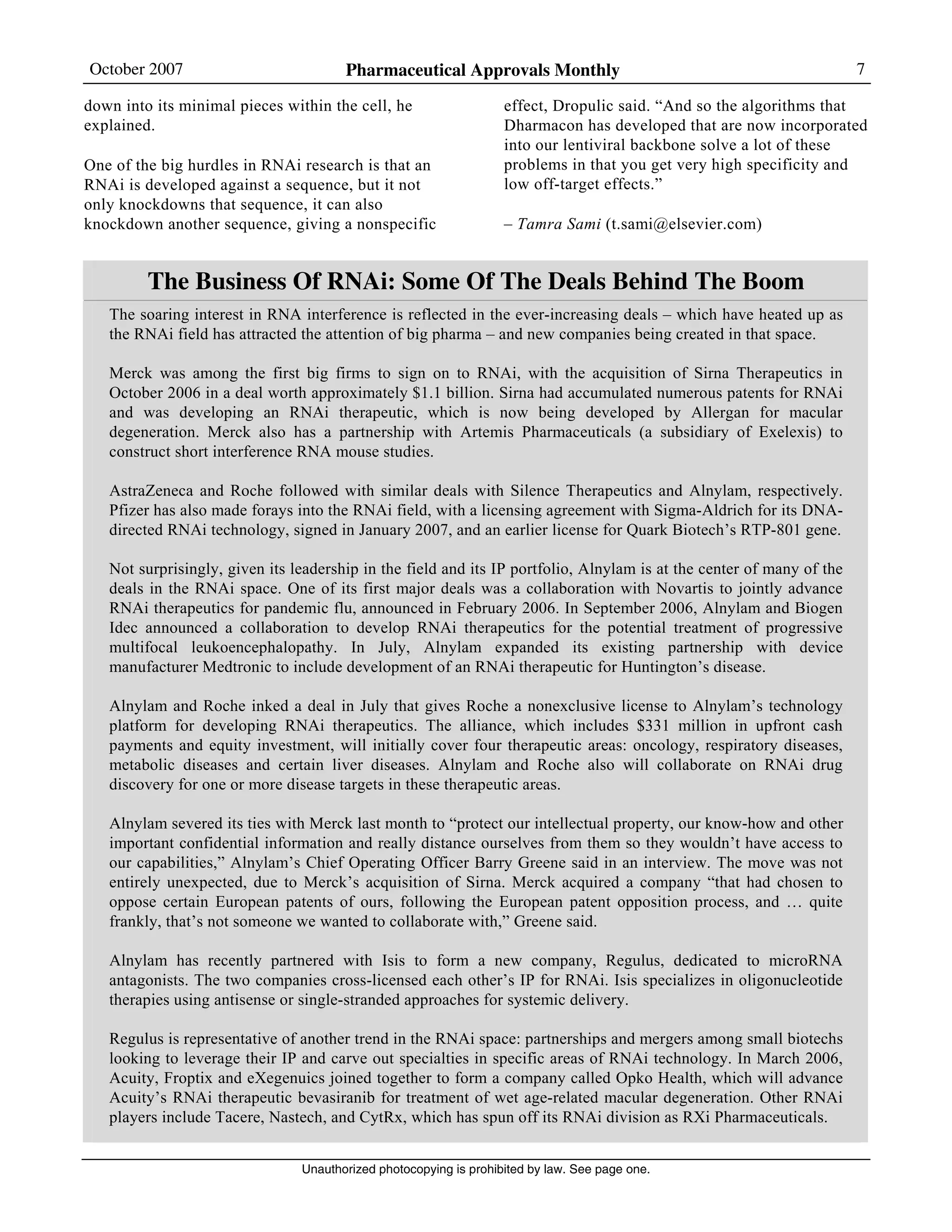This document summarizes the state of RNA interference (RNAi) therapeutics development. It discusses the major challenge of delivery for this new class of drugs and describes different delivery approaches being pursued. Direct delivery to specific organs through injection or inhalation is further along, with Opko Health's eye drug bevasiranib in Phase III trials. Systemic delivery, which is more difficult, involves chemically modifying siRNA or using viral vectors. The document also provides background on RNAi discovery and development timelines. It notes that Alnylam holds many important RNAi patents and considers itself the leader in the field due to its intellectual property position and progress in clinical development.




![October 2007 Pharmaceutical Approvals Monthly 5
Unauthorized photocopying is prohibited by law. See page one.
to man, and [now] we’re on the verge of an
astonishing proof of concept by the end of the year.
And we’ve also tackled one of the most important
questions, which is how does one effectively deliver
these therapeutics?”
For systemic delivery, Alnylam’s liposomal
approach of encapsulating a drug in liposomes and
injecting it intravenously shows great promise, he
said. Other approaches include antibody conjugation
or peptide conjugation.
The company published a study in the Sept. 17 issue
of Nature in which lipid conjugates of siRNAs that
facilitate in vivo systemic delivery were found to
associate with circulating lipoprotein particles and
to achieve cellular uptake through receptors for low-
density lipoprotein and high-density lipoproteins.
Results of that study have implications for the
company’s hypercholesterolemia RNAi therapeutic,
which is directed to a disease target called PCSK9.
Targeting Multiple Cancer Pathways
The other systemic target Alnylam is chasing is liver
cancer. ALNVSP01 encapsulates two siRNAs in one
liposomal formulation that targets two different cancer
pathways: VEGF and kinase spindle protein. “So we
think that anti-angiogenic and the antiproliferative
approach is a powerful way to go at a pathology. …
You can’t ideally tackle most cancers by just one drug
targeting one pathway. So this combined approach,
which RNAi affords, allows you to go at multiple
intervention points in a cancer,” Vaishnaw said.
Both PCSK9 and VSP01 are IND candidates for
2007, according to Vaishnaw.
Alnylam has recently partnered with Isis to form a
new company, Regulus, dedicated to microRNA
antagonists. The two companies cross-licensed each
other’s IP for RNAi. Isis specializes in
oligonucleotide therapies using antisense or single-
stranded approaches for systemic delivery.
Hitting Multiple HCV Pathway Targets
Tacere Therapeutics, which is focusing on
infectious diseases using RNAi, is using the vector
approach to systemic delivery.
Tacere’s lead RNAi compound is triple vector
TT-033, which is composed of three individual
short hairpin RNAs targeting three independent
regions of hepatitis C simultaneously. HCV, like
HIV, is an RNA virus that mutates very quickly, so
“you have to hit multiple regions simultaneously,”
Tacere Therapeutics CEO Sara Hall told
Pharmaceutical Approvals Monthly.
“If you’re using something like RNA interference where
you’re targeting the viral sequences themselves, and if
you’re only targeting one 19-23 nucleotide region of a
fairly long viral genome, it can introduce a silent point
mutation that doesn’t even affect the fitness of the virus,
but you completely lose the inhibitory activity of the
RNAi drug,” she said. “We knew from our experience of
RNA viruses that we had to hit multiple regions
simultaneously.”
“By using the ability of expressed RNAi, we could
string multiple sequences together. So not only
could we multitarget them, but we could also cross
genotypes of HCV,” Hall said. There are six
predominant genotypes of HCV worldwide. “We
looked at patient isolates across all the different
genotypes and pulled out conserved regions, so that
between the three targets we could hit basically
every genotype of HCV. Because the capability was
there, we just captured the full power of RNAi.”
Delivering RNAi to the liver is difficult because it
is a heterogenous organ with many different cell
types that are difficult to penetrate. Tacere chose an
adeno-associated virus – a very small virus, which
is nonpathogenic and replication incompetent. A
protein capsid, the vector is gutted so that it has no
viral genes in it but contains the three shRNAs.
“FDA likes the AAV because it doesn’t cause a
primary immune response and there is no targeted
integration of it like retroviruses … your body will
clear it over time,” Hall explains. “RNAi is an
incredibly powerful mechanism because it is totally
catalytic and doesn’t require much input. … If you
can knock down the viral load two logs or greater
for 12 weeks, that’s indicative of a sustained
biologic response and that’s the approval criteria
you need to have,” she said, adding that HCV does
not integrate, and since there is no replenishing
source, once it is cleaved, the virus is gone.
Tacere had a pre-IND meeting with FDA in June and got
“a very big thumbs up from CBER,” Hall said. “They’re
really excited about it because this is only the third RNAi
drug that they’ve seen on the scene” (see chart of
compounds in the pipeline, p. 6). She explained that the
two frontrunners for AMD indications (both direct
delivery) went through FDA’s Center for Drugs. Tacere
anticipates initiating Phase I trials in the second or third
quarter of 2008, and is in the process of finalizing
protocols with FDA.](https://image.slidesharecdn.com/d1c63334-dc04-4a73-877e-5376859aa950-160907005000/75/RNAI-PAM-Oct-07-5-2048.jpg)
![6 Pharmaceutical Approvals Monthly October 2007
Unauthorized photocopying is prohibited by law. See page one.
RNAi Pipeline Candidates
Selected compounds in the RNAi pipeline; list may not include all candidates.
Company & compound Indication/target Phase Delivery method
Opko (formerly Acuity)
Bevasiranib
AMD (targets VEGF) III Direct eye injection
Alnylam
ALN-RSV01
RSV II Direct to lungs via inhaler
Alnylam
[unnamed]
Hypercholesterolemia
(targets PCSK9)
IND 2007 candidate Systemic (blood) liposomal
conjugation
Alnylam
ALN-VSP01
Liver cancer (targets VEGF
and KSP)
IND 2007 candidate Systemic (liver) liposomal
conjugation
Allergan
AGN211745 (previously
Sirna 027)
Wet AMD II Direct eye injection
City of Hope [unnamed] HIV AIDS I Systemic – lentiviral vector
Silence Therapeutics
RIP801i
AMD I Direct eye injection
Tacere
TT-033
Hepatitis C IND 2008 candidate Systemic – AAV vector
Nucleonics
NUCB1000
Hepatitis B IND candidate Systemic – expressed
plasmid in a liposome
Tacere and Japanese Oncolys BioPharma entered
into a strategic development alliance whereby
Oncolys acquires the Asian rights of TT-033, which
the company will develop as OBP-701.
City of Hope HIV RNAi Stem-Cell Therapy
Meanwhile, City of Hope, a Los Angeles-based
research hospital, has begun Phase I trials of its
RNAi therapy using a lentiviral vector to
encapsulate three different genetically engineered
genes into stem cells to fight the HIV virus.
“In essence, what we did was make this siRNA
inside of cells but without any virus being present,
so there’s no target,” Division of Molecular Biology
Professor John Rossi said. “Previous studies had
demonstrated that certain combinations of siRNAs
activate the cell’s innate immune response. Since
we had one of these combinations in our siRNA
targeting HIV, it became paramount to determine
whether or not this combination was active when it
was produced by the cell. Our focus was to identify
whether there was any toxic side effect from our
process. And there wasn’t.”
The Phase I trial will study the RNAi therapeutic in
five patients who have both AIDS and AIDS-related
lymphoma.
Customized Lentiviral Vectors To The Rescue
Lentigen custom-designs lentiviral vectors for
companies competing in the RNAi space. It recently
joined forces with Dharmacon, a company that
assists with RNAi discovery and technology, to
launch a RNAi research product called SmartVector
that delivers highly specific RNA constructs with
better delivery technologies.
The SmartVector “incorporates the proprietary
microRNA and RNAi algorithms that Dharmacon
has spent a lot of time developing,” Lentigen CEO
Boro Dropulic told Pharmaceutical Approvals
Monthly. Dharmacon focused on siRNAs, but they
also tend to have a short-term effect and some cell
types are more difficult to penetrate, Dropulic said.
“Lentiviral vectors solve both of those two
fundamental problems. You can get stable
expression of the RNAi in the cell so that you can
create cell lines with knockdowns, and lentiviral
vectors allow you to get RNAi into difficult-to-
transfuse cells,” he said.
Dharmacon’s RNAi is imbedded with a microRNA
transcript, which allows for better processing
because the RNAi functions best when it is cut](https://image.slidesharecdn.com/d1c63334-dc04-4a73-877e-5376859aa950-160907005000/75/RNAI-PAM-Oct-07-6-2048.jpg)
